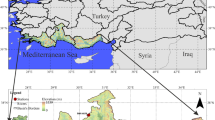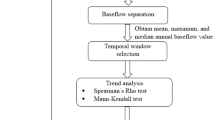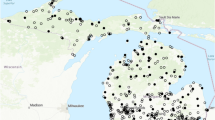Abstract
Streamflow statistics are commonly used for purposes of planning and managing water resources in the Susquehanna River Basin. For accurately estimating streamflow statistics, it is important to identify whether there are increasing or decreasing changes during the period of records and whether the change is gradual or abrupt. This study employs repeated monotonic trend tests with varying beginning and ending time for detecting changes in streamflow in tributaries within the Susquehanna River Basin. The method is employed to analyze long-term streamflow trends and detect change for annual minimum, median, and maximum daily streamflow for eight unregulated watersheds within the basin. Monthly baseflow and storm runoff are investigated. The results show a considerable increase in annual minimum flow for most of the examined watersheds and a noticeable increase in annual median flow for about half of the examined watersheds. Both these streamflow increases were abrupt, with only a few years of transition centered around 1970. The abrupt change in annual minimum and median flows appears to occur in the summer and fall seasons. The abrupt change in annual minimum and median flows is due to increased flows in the summer and fall seasons. The results also indicate there is no long-term significant increasing or decreasing change in annual maximum flow in the examined watersheds.
Similar content being viewed by others
References
Chen W, Lee C (2003) Estimating ground-water recharge from streamflow records. Environ Geol 44:257–265
Dery SJ, Stahl K, Moore RD, Whitfield PH, Menounos B, Burford JE (2009) Detection of runoff timing change in pluvial, nival, and glacial rivers of western Canada. Water Resour Res 45:W04426. doi:10.1029/2008WR006975
Douglas EM, Vogel RM, Kroll CN (2000) Trends in floods and low flow in the United States: impact of spatial correlation. J Hydrol 240:90–105
Groisman PY, Knight RW, Karl TR (2001) Heavy precipitation and high streamflow in the contiguous United States: trends in the 20th century. Bull Am Meteorol Soc 82:219–246
Helsel DR, Hirsch RM (1992) Statistical methods in water resources. Elsevier, New York
Hirsch RM, Slack JR (1984) A non-parametric trend test for seasonal data with serial dependence. Water Resour Res 20:727–732
Institute of Hydrology (1980a) Low flow studies. Report No 1. Institute of Hydrology, Wallingford, Oxon, UK
Institute of Hydrology (1980b) Low flow studies. Report No 3. Institute of Hydrology, Wallingford, Oxon, UK
Kalra A, Piechota TC, Davies R, Tootle GA (2008) Changes in U.S. streamflow and Western US snowpack. J Hydrol Eng 13(3):156–163
Kendall MG (1962) Rank correlation methods, 3rd edn. Hafner, New York
Koutsoyiannis D (2002) The Hurst phenomenon and fractional Gaussian noise made easy. Hydrol Sci J 47(4):573–595
Koutsoyiannis D (2003) Climate change, the Hurst phenomenon, and hydrological statistics. Hydrol Sci J 48(1):3–24
Koutsoyiannis D, Montanari A (2007) Statistical analysis of hydroclimatic time series: uncertainty and insights. Water Resour Res 43:W05429. doi:10.1029/2006WR005592
Koutsoyiannis D, Montanari A, Lins HF, Cohn TA (2009) Climate, hydrology and freshwater: towards an interactive incorporation of hydrological experience into climate research—DISCUSSION of “The implications of projected climate change for freshwater resources and their management”. Hydrol Sci J 54(2):394–405
Kroll CN, Luz JG, Allen TB, Vogel RM (2004) Developing a watershed characteristics database to improve low streamflow prediction. J Hydrol Eng, ASCE 9(2):116–125
Kulkarni A, von Storch H (1995) Monte Carlo experiments on the effect of serial correlation on the Mann–Kendall test of trend. Met Z 4(2):82–85
Lettenmaier DP, Wood EF, Wallis JR (1994) Hydro-climatological trends in the continental United States, 1948–88. J Climate 7:586–607
Lins HF, Slack JR (1999) Streamflow trends in the United States. Geophys Res Lett 26(2):227–230
Lins HF, Stakhiv EZ (1998) Managing the nation’s water in a changeing climate. J Am Water Res Assoc 34(6):1255–1264
Mann HB (1945) Nonparametric test against trend. Econometrica 13:245–259
McCabe GJ, Wolock DM (2002) A step increase in streamflow in the conterminous United States. Geophys Res Lett 29(24):2185. doi:10.1029/2002GL015999
Miller WP, Piechota TC (2008) Regional analysis of tend and step change observed in hydroclimatic variables around the Colorado River basin. J Hydrometeorol 9(5):1020–1034
Milly PCD, Betancourt J, Falkenmark M, Hirsch RM, Kundzewicz ZW, Lettenmaier DP, Stouffer RJ (2008) Stationarity is dead: whither water management. Science 319:573–574
Slack JR, Landwehr JM (1992) Hydro-climatic data network: a U.S. Geological Survey streamflow data set for the United States for the study of climate variations, 1874–1988. US Geological Survey Open File Report 92–129
Sloto RA, Crouse MY (1996) Hysep: a computer program for streamflow hydrograph separation and analysis. US Geological Survey Water Resources Investigation Report 96-4040
Susquehanna River Basin Commission (SRBC) (2006) Conowingo pond management plan. SRBC publication no 242
Vogel RM, Bell CJ, Fennessey NM (1997) Climate streamflow and water supply in the northeastern United States. J Hydrol 198(1–4):42–68
von Storch H (1995) Misuses of statistical analysis in climate research. In: von Storch H, Navarra A (eds) Analysis of climate variability: applications of statistical techniques. Springer, Berlin, pp 11–26
Wahl TL (1988) BFI, a computer program for determining an index to base flow. FORTRAN
Wahl KL, Wahl TL (1988) Effects of regional ground-water declines on streamflow in the Oklahoma Panhandle. Symposium on Water-Use Data for Water Resources Management. American Water Resources Association, Tucson, AZ, pp 239–249
Wu H, Soh L-K, Smal A, Chen X-H (2008) Trend analysis of streamflow drought events in Nebraska. Water Resour Manage 22:145–164
Yue S, Pilon P (2003) Interaction between deterministic trend and autoregressive process. Water Resour Res 39(4):1077. doi:10.1029/2001WR001210
Yue S, Wang CY (2002) Applicability of prewhitening to eliminate the influence of serial correlation on the Mann–Kendall test. Water Resour Res 38(6):1068. doi:10.1029/2001WR000861
Yue S, Wang CY (2004) The Mann–Kendall test modified by effective sample size to detect trend in serially correlated hydrological series. Water Resour Manage 18:201–218
Yue S, Pilon P, Cavadias G (2002a) Power of the Mann–Kendall and Spearman’s rho tests for detecting monotonic trends in hydrological series. J Hydrol 259:254–271
Yue S, Pilon P, Phinney B, Cavadias G (2002b) The influence of autocorrelation on the ability to detect trend in hydrological serials. Hydrol Process 16:1807–1829
Zhang Z, Kroll C (2007a) Closer look at the baseflow correlation method. J Hydrol Eng, ASCE 12(2):190–196. doi:10.1061/(ASCE)1084-0699(2007)12:2(190)
Zhang Z, Kroll C (2007b) The baseflow correlation method with multiple gauged sites. J Hydrol 347(3–4):371–380. doi:10.1016/j.jhydrol.2007.09.025
Zhang Z, Dehoff AD, Pody RD (2010) A new approach to identify trend pattern of streamflow. J Hydrol Eng, ASCE. doi:10.1016/(ASCE)HE.1943-5584.0000179
Zhu J, Day RL (2005) Analysis of streamflow trends and the effects of climate in Pennsylvania, 1971 to 2001. J Am Water Resour Assoc 41(6):1939–1405
Author information
Authors and Affiliations
Corresponding author
Rights and permissions
About this article
Cite this article
Zhang, Z., Dehoff, A.D., Pody, R.D. et al. Detection of Streamflow Change in the Susquehanna River Basin. Water Resour Manage 24, 1947–1964 (2010). https://doi.org/10.1007/s11269-009-9532-0
Received:
Accepted:
Published:
Issue Date:
DOI: https://doi.org/10.1007/s11269-009-9532-0




